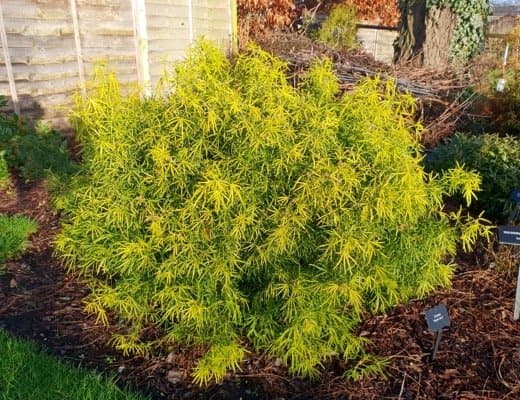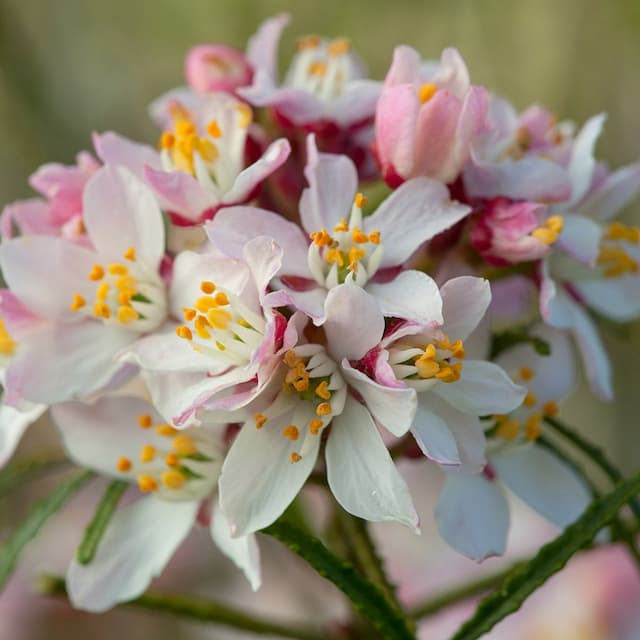Bee Bee Tree Tetradium daniellii

ABOUT
The common name for Tetradium daniellii is the bee bee tree. It is a deciduous tree, which means it loses its leaves seasonally. The foliage of the bee bee tree is quite lush and comprised of compound leaves that are made up of several small, oval to lance-shaped leaflets. These leaflets are arranged oppositely on the leaf stem, creating a feather-like pattern known as pinnate. In their maturity, the leaves tend to display a glossy, deep-green color, offering a vigorous backdrop to the blooms. The flowers of the bee bee tree are one of its most notable features, which appear in large, fragrant clusters. Each cluster is a conglomeration of tiny creamy-white flowers. They tend to attract a lot of bees, which is how the tree got its common name. These clusters bloom in summer and can create an almost frothy appearance amidst the green leaves. Following the flowering period, the tree produces small, round fruits that mature to a black or dark purple color. These fruits are a source of food for wildlife, adding an ecological benefit to its ornamental appeal. The bark of the bee bee tree is another point of interest; it is typically grayish-brown and may show furrows or ridges along the maturity of the tree, adding texture to the landscape even in the dormant months when leaves are absent.
About this plant
 Names
NamesFamily
Rutaceae
Synonyms
Korean Evodia, Bee Bee Tree, Bee Tree
Common names
Euodia daniellii, Euodia hupehensis, Tetradium hupehense.
 Toxicity
ToxicityTo humans
The Bee Bee tree is not widely known for being poisonous to humans. There is limited information available about its toxicity, and it does not appear in major databases as a commonly toxic plant. However, it's always advisable to be cautious and avoid ingesting parts of plants that are not known to be edible. Bee Bee tree is primarily planted for ornamental purposes and its nectar, which is attractive to bees.
To pets
The Bee Bee tree is not widely recognized for its toxicity to pets. There's little evidence to suggest that Tetradium daniellii is highly toxic to domestic animals. However, as with any non-food plant, it is generally best to prevent pets from ingesting it, as it may cause gastrointestinal upset or an unexpected allergic reaction due to the animal's individual sensitivity.
 Characteristics
CharacteristicsLife cycle
Perennials
Foliage type
Deciduous
Color of leaves
Green
Flower color
White
Height
20-30 feet (6-9 meters)
Spread
20-30 feet (6-9 meters)
Plant type
Tree
Hardiness zones
5-9
Native area
Korea China
Benefits
 General Benefits
General Benefits- Attracts Pollinators: Bee Bee Tree is known for its ability to attract bees and other pollinators, benefiting the local ecosystem.
- Ornamental Value: With its showy clusters of fragrant white flowers in summer, it's a popular choice for ornamental gardens.
- Shade Provider: This tree can offer shade in landscapes and urban environments due to its canopy.
- Honey Production: The flowers are a nectar source for honeybees, which can produce a unique honey from it.
- Wildlife Habitat: It provides food and shelter for various birds and insects, supporting biodiversity.
- Drought Tolerance: Once established, Bee Bee Tree can tolerate drought conditions, reducing the need for watering.
 Medical Properties
Medical Properties- Anti-inflammatory: The plant is believed to contain compounds that may help reduce inflammation.
- Analgesic: Traditional use suggests that it might have pain-relieving properties.
- Antioxidant: It may contain antioxidants, which can help in preventing or delaying some types of cell damage.
- Antibacterial: Some studies indicate that extracts from the plant could have antibacterial properties.
- Anti-allergic: There is some evidence to suggest that the plant may have anti-allergic effects.
 Air-purifying Qualities
Air-purifying QualitiesThis plant is not specifically known for air purifying qualities.
 Other Uses
Other Uses- Tetradium daniellii wood, often known as Korean Evodia, can be utilized for woodworking and carving objects due to its firm texture.
- The flowers of Korean Evodia are a source of nectar and can be used in apiculture to produce a uniquely flavored honey.
- The leaves of Korean Evodia can serve as a natural dye, imparting a greenish color to fabrics when used in traditional dyeing processes.
- Korean Evodia seeds are sometimes used in jewelry making for their unique appearance when dried and polished.
- The tree's dense foliage can be utilized in landscape design to create privacy screens or hedges in residential and public gardens.
- Korean Evodia's fallen leaves can contribute to mulch for garden beds, helping to retain moisture and suppress weeds.
- The tree can be used as an educational resource in botanical studies to explain the characteristics and growth patterns of the Rutaceae family.
- Korean Evodia's strong root system is sometimes used for erosion control in sloped areas to stabilize the soil.
- The plant can be employed in the art of bonsai, where its blooming nature and hardy characteristics lend well to cultivation in miniature form.
- Korean Evodia can attract a variety of insects and birds, and therefore can be integrated into wildlife gardens to promote biodiversity.
Interesting Facts
 Feng Shui
Feng ShuiThe Bee Bee tree is not used in Feng Shui practice.
 Zodiac Sign Compitability
Zodiac Sign CompitabilityThe Bee Bee tree is not used in astrology practice.
 Plant Symbolism
Plant Symbolism- Attraction: The Tetradium daniellii, commonly known as the Korean Evodia or Bee Bee Tree, produces flowers that are highly attractive to bees, symbolizing allure and magnetism.
- Healing: In traditional medicine, parts of the Korean Evodia are used for their healing properties, representing health and recovery.
- Adaptability: This plant's ability to thrive in a variety of conditions signifies versatility and resilience.
- Prosperity: The abundant nectar of the Korean Evodia's flowers that provides food for bees has been associated with wealth and abundance.
 Water
WaterThe Bee Bee Tree, commonly known as Tetradium daniellii, should be watered deeply and thoroughly, ensuring that the soil is moistened to a depth of several inches. Initially, water the Bee Bee Tree once a week, allowing the soil to dry out slightly between waterings. Once established, the tree is quite drought-tolerant and may only require additional water during extended dry spells. During hot and dry weather, it may benefit from up to 5 gallons every two weeks, depending on the size of the tree and the soil conditions.
 Light
LightThe Bee Bee Tree prefers full sun to partial shade, thriving best in a location where it can receive at least six hours of direct sunlight each day. An ideal spot for the Bee Bee Tree would be in an open area away from taller structures or trees that could block sunlight.
 Temperature
TemperatureThe Bee Bee Tree is hardy and can withstand a temperature range of approximately -20°F to 100°F; however, the ideal growing temperature for this tree is between 60°F and 85°F. It is important to avoid exposure to extreme cold and frost when young, as this could potentially damage the plant.
 Pruning
PruningPruning the Bee Bee Tree should be done to shape the plant, remove any dead or diseased wood, and encourage a strong structure. The best time for pruning is late winter or early spring before new growth starts. Prune sparingly, as heavy pruning can reduce the tree's flowering.
 Cleaning
CleaningAs needed
 Soil
SoilThe Korean Evodia (Tetradium daniellii) thrives best in well-draining soil with a pH range between 6.0 and 7.5. A mix containing loamy garden soil, compost, and a portion of sand or perlite is ideal to facilitate proper drainage and aeration.
 Repotting
RepottingThe Korean Evodia should be repotted every 2-3 years or when it outgrows its pot. Younger trees may need more frequent repotting while mature ones can be repotted less often.
 Humidity & Misting
Humidity & MistingKorean Evodia prefers moderate humidity levels but is tolerant of various conditions. Aim for a humidity level around 40-50% for optimal growth.
 Suitable locations
Suitable locationsIndoor
Provide bright indirect light, mild humidity, and good airflow for the Korean Evodia.
Outdoor
Plant the Korean Evodia in full sun to partial shade and shelter from harsh winds.
Hardiness zone
5-9 USDA
 Life cycle
Life cycleThe Korean evodia (Tetradium daniellii) begins its life as a seed, which germinates in the spring under appropriate temperature and moisture conditions. After germination, the seedling emerges and develops into a young sapling, focusing on root and shoot growth. As it matures into a juvenile tree, it establishes a robust root system and begins to grow in height and girth, producing compound leaves. Once reaching maturity, the Korean evodia starts to flower, typically during the summer months, with clusters of small, fragrant white flowers that attract pollinators, predominantly bees. Following pollination, the flowers develop into small fruit capsules containing seeds, which mature by late summer or early fall. These seeds can then be dispersed by birds and animals, or they may fall to the ground near the parent plant, ready to begin the life cycle anew when conditions are favorable.
 Propogation
PropogationPropogation time
Late winter-early spring
Propogation: The Bee Bee tree (Tetradium daniellii) is primarily propagated through seed. The best time for seed propagation is in fall or early winter when the seeds are ripe and freshly collected. To propagate by seed, the collected seeds need to be sown immediately as they have a short viability period. They should be sown in a cold frame as soon as they are ripe. The seeds require a period of cold stratification to break dormancy, which can be achieved naturally by the winter cold if sown outdoors. This is the most popular method of propagation for the Bee Bee tree. Once germinated, the seedlings are grown in the cold frame for their first winter, and then they can be planted out into their permanent positions in late spring or early summer, after the last expected frosts.









